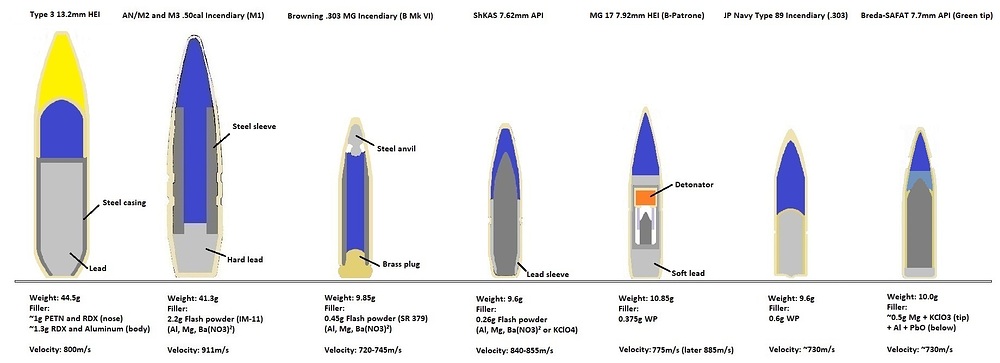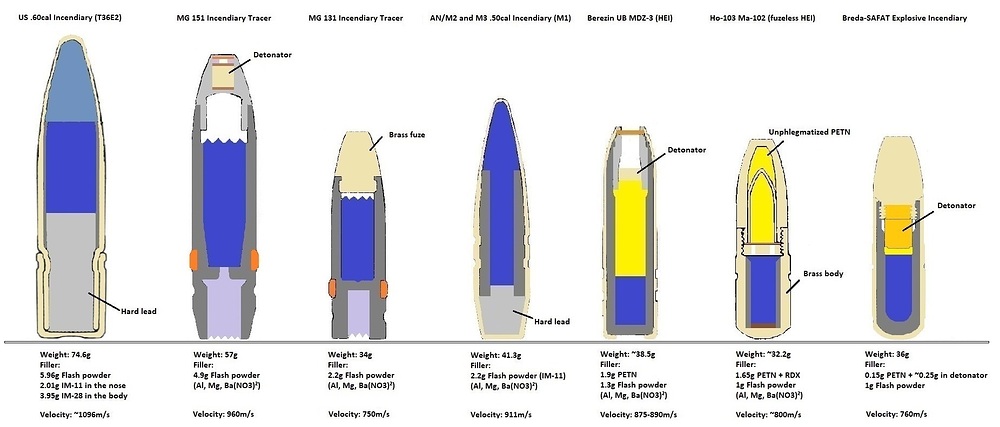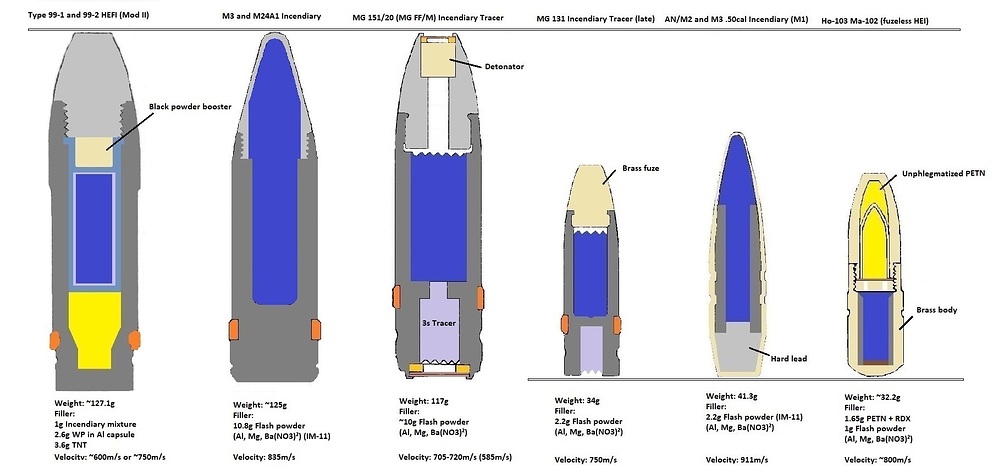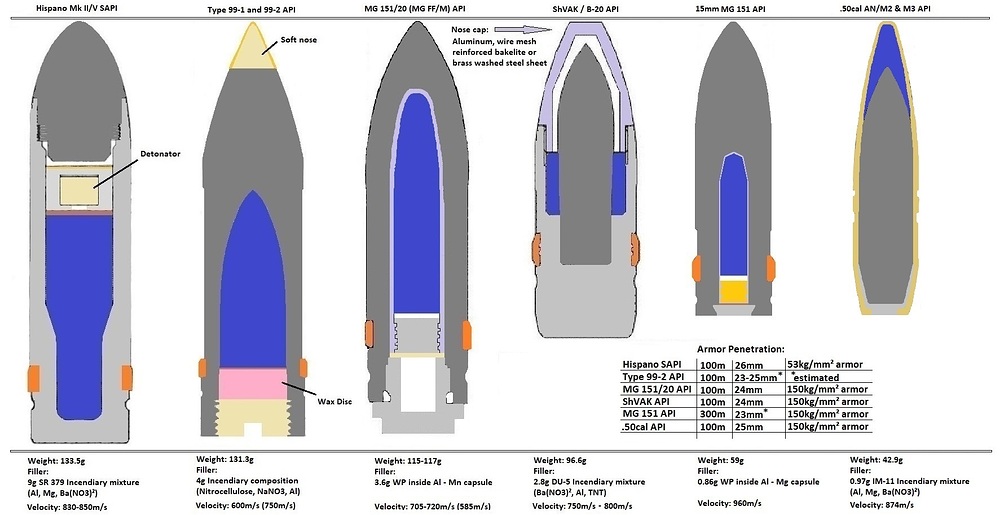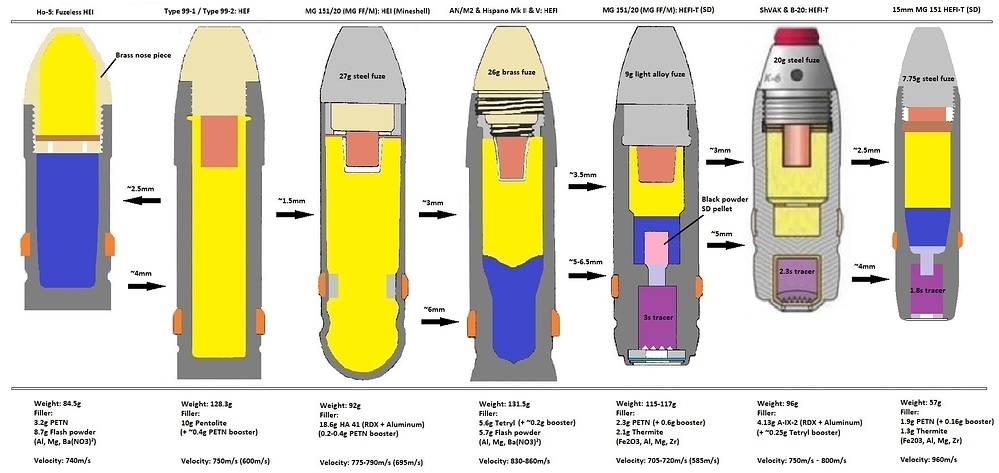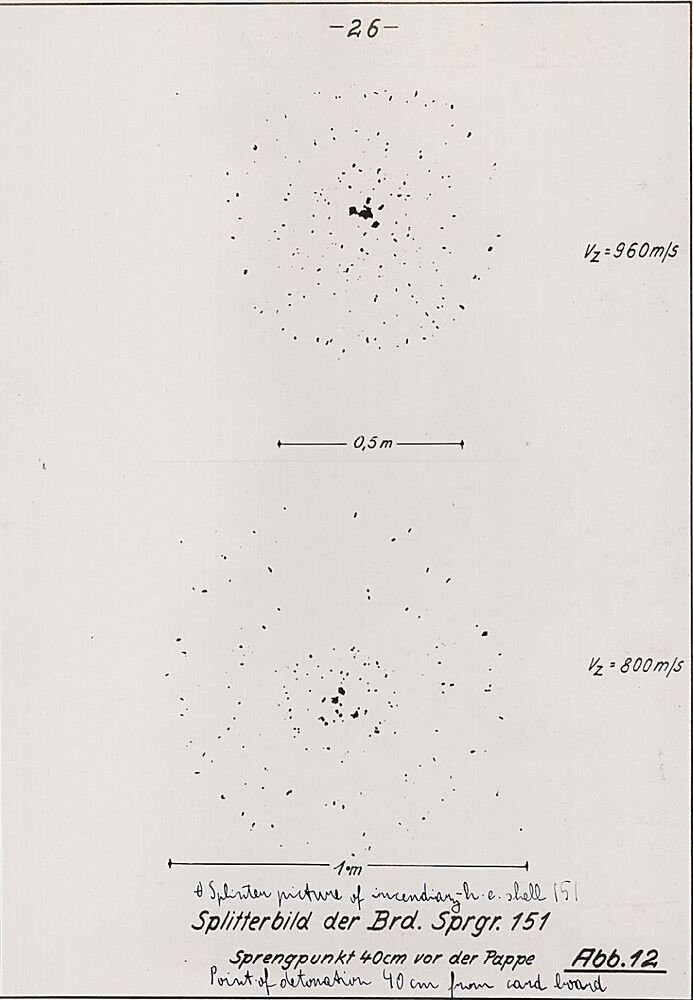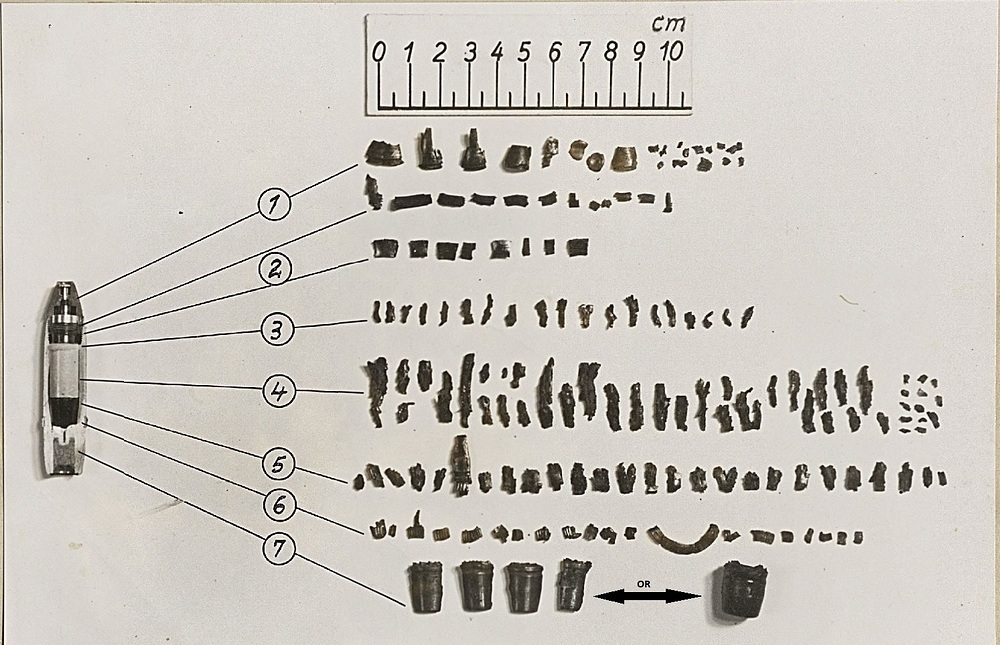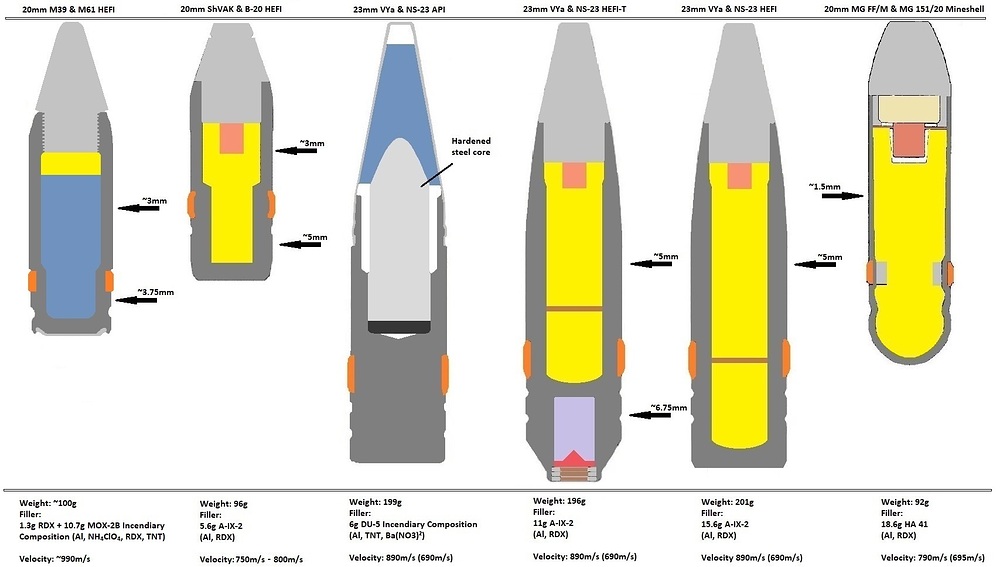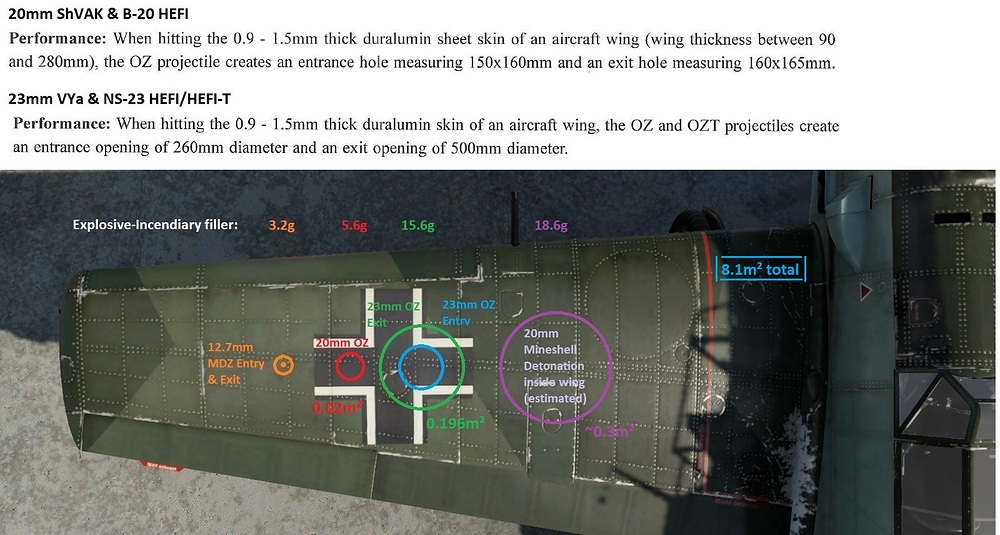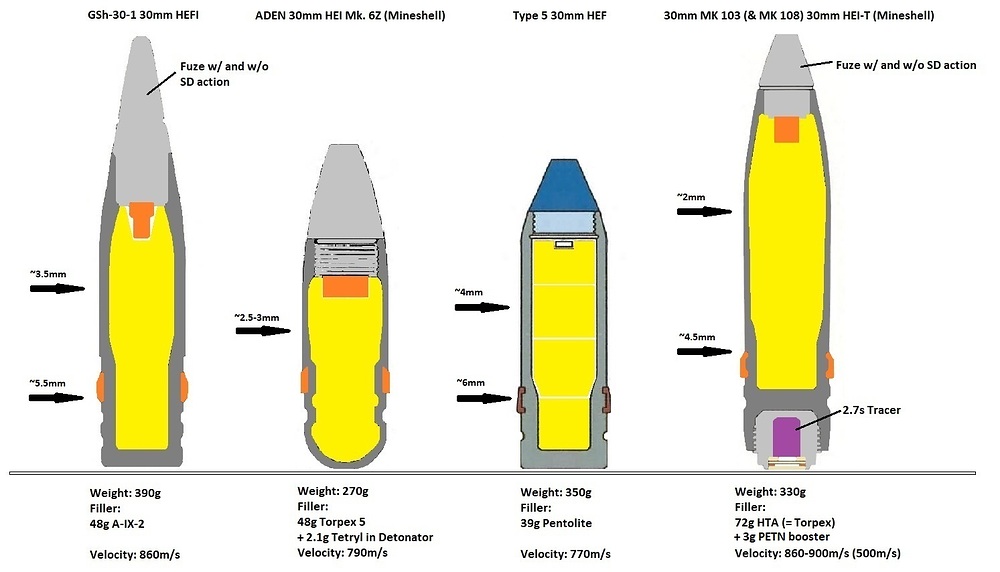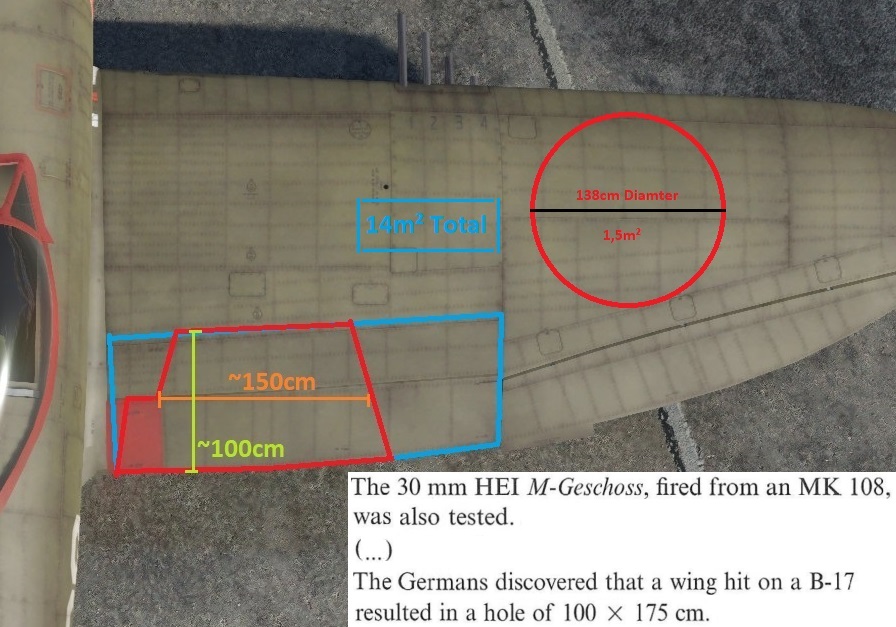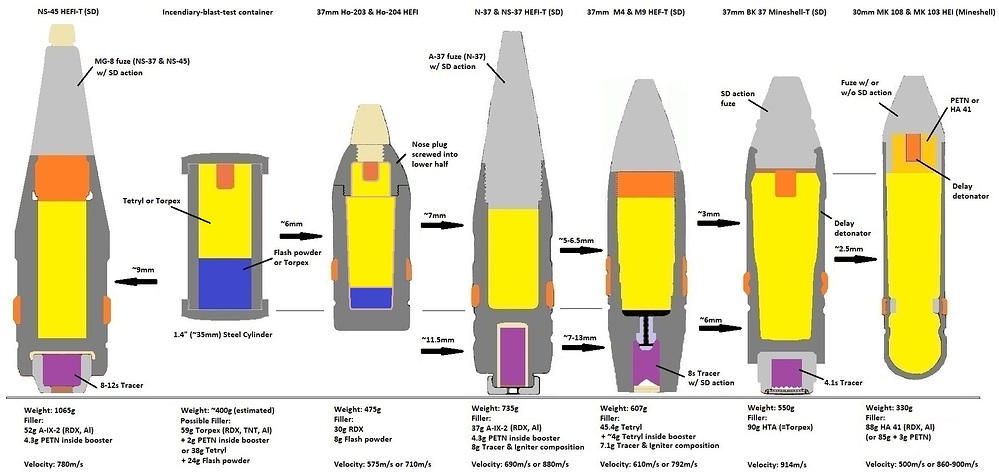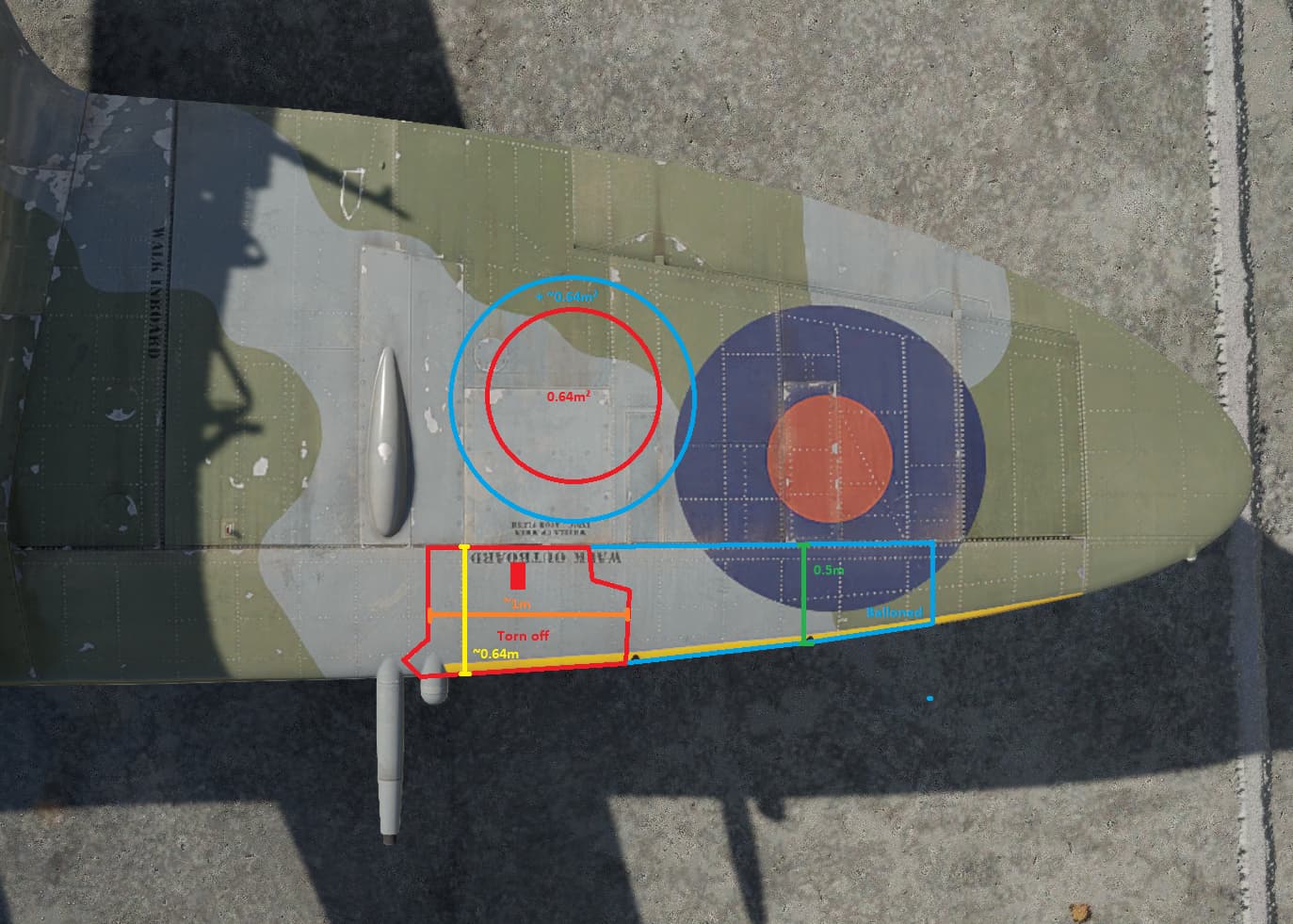The shells and bullets are more or less based on a 1:1 scale.
7.7-7.92mm LMG Incendiary ammunition compared to 12.7 and 13.2mm HMG rounds
It’s clear how ineffective rifle caliber bullets are in comparison to even heavy machine gun bullets, since they can only carry little chemical contents.
20mm Incendiary rounds compared to HMG
20mm Explosive and Explosive-Incendiary rounds. 15mm shell for comparison
20mm Mineshell damage to Spitfire wing:

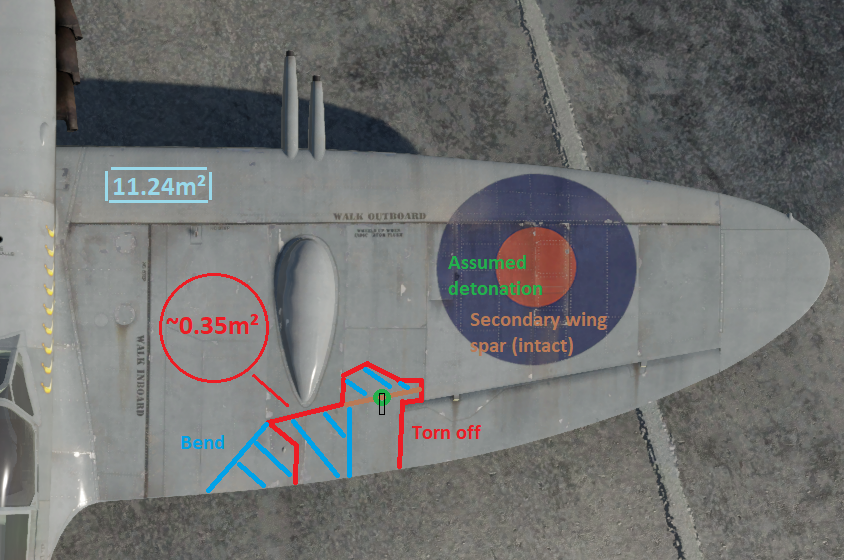
37mm shells and larger. 30mm Mineshell for comparison.
Blast Test container vs. Spitfire wing:
Damage of blast:
High structural damage but the main spar isn’t compromised other than a large hole in the center of it, as the blast escapes through the thin duralumin skin.
A portion of the skin is blown aways while a large part “balloons”, deforming from the pressure.
30mm Mineshell damage to Spitfire wing (Type B)
Damage of NS-37 and NS-45 shells against a Bf 109 and Ju 87 wing:

NS-37 hole diamater based on wing area destroyed.
- Entry: 30cm (Bf 109), 32cm (Ju 87)
- Exit: 76.5cm (Bf 109), 67cm (Ju 87)
NS-45 hole diamter:
- Entry: μ=58cm (Bf 109), μ=66.8cm (Ju 87)
- Exit: μ=87.8cm (Bf 109), μ=91.3cm (Ju 87)
Blast comparison to 30mm Mineshell:
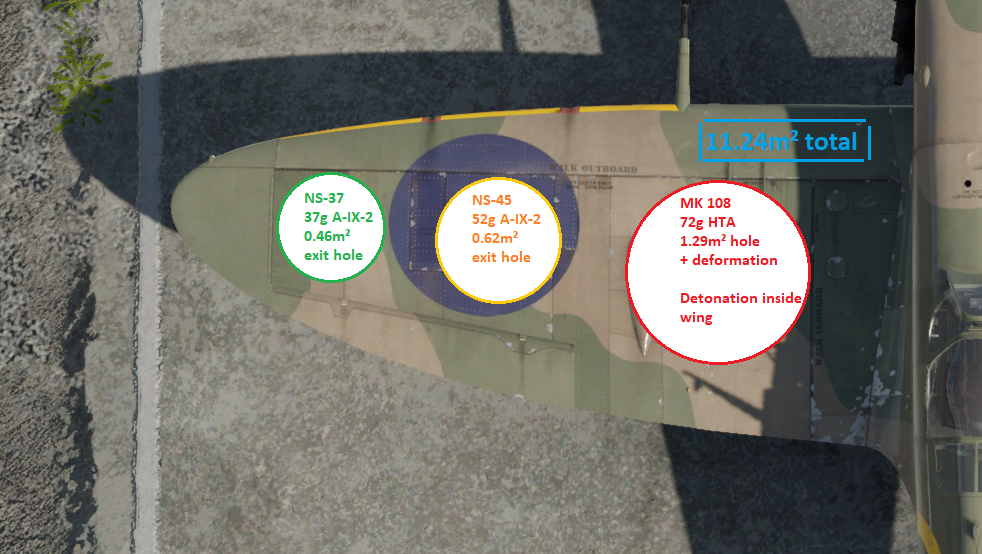
Fragmentation of a N-37 HEFI-T shell:

Out of ~660g recovered fragments from of the ~690g body&fuze, 84.42% (~557.2g) are effective steel fragments with a weight of above 0.5g.
- 9.4% (62g) with a weight between 0.5-1g
- 15% (99g) with a weight between 1-2g
- 11.4% (75g) with a weight between 2-4g
Larger fragments, like parts of the nose fuze and tracer tail assembly, can penetrate armor protecting fuel tanks or pilot and cause lethal damage to fuel tanks.
Comparison of fragment distribution of 30mm HEFI and HEI (Mineshell):
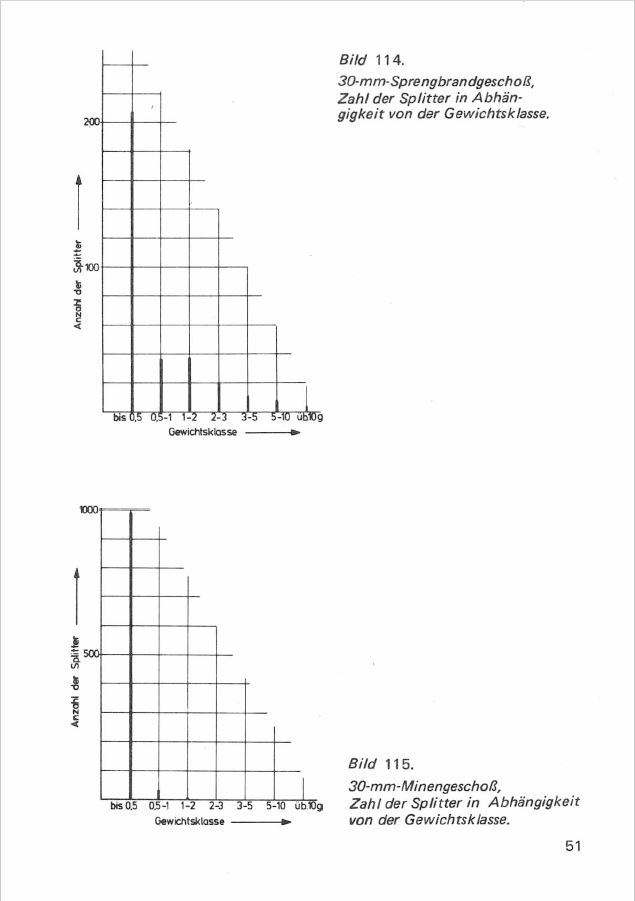
Mineshells, for the most part, only produce a large number of small fragments with a weight of only up to 0.5g, which quickly lose their velocity over a short distance.
Regular explosive rounds produce a much higher number of effective fragments.
——————————
Assessment of (aluminized) explosive content against an aircrafts wing:
| Ammunition | Explosive amount | Damage in m² | Ratio m²/g | Notes |
|---|---|---|---|---|
| 12.7mm MDZ-3 | 3.2g PETN & Flash powder | 0.0095m² | 0.0030 | Exit hole |
| 20mm OZ | 5.6g A-IX-2 | 0.02m² | 0.0036 | |
| 23mm OZ | 15.6g A-IX-2 | 0.196m² | 0.0125 | Exit hole |
| 20mm Mineshell | 18.6g HA 41 | ~0.35m² | 0.0188 | Mineshell |
| 37mm OZT | 37g A-IX-2 (+4g PETN) | 0.46m² | 0.0112 | Exit hole |
| 45mm OZT | 52g A-IX-2 (+4g PETN) | 0.62m² | 0.0111 | Exit hole |
| 35mm Test Container | 59g Torpex (+2g PETN) | ~0.73m² | 0.0120 | Test Container |
| 30mm Mineshell w/ Tracer | 72g Torpex (+3g PETN) | ~1.29m² | 0.0172 | Mineshell |
| 30mm Mineshell w/o Tracer | 88g HA 41 | 1.75m² | 0.0199 | Mineshell |
It’s noticable that Mineshells achive a higher destruction ratio than thick walled explosive rounds, presumably because less energy is used to break the shell casing appart.
The actual damage is even larger, as bulging or balloning of the structure isn’t considered, only structure that is actually torn appart.
Another explanation would be the detonation inside the wing, even though the 35mm test container, which was detonated inside a wing, didn’t cause as much damage as Mineshells.
With the exception of the 12.7mm Berezin and 20mm ShVAK, all other projectiles seem to follow a similiar destruction ratio.
The small explosive content of the ShVAK and Berezin are probably unable to cause enough pressure built-up inside a duralumin wing to cause heavy blast damage from overpressure.
——————————
Required number of hits for the destruction of a four engined bomber (B-17), based on German assessment:
| Caliber | Shell weight | Required hits | Explosive content | Total content | Blast damage ratio | Blast damage | Fragmentation weight | Notes |
|---|---|---|---|---|---|---|---|---|
| 15mm | 57g | 75 | ~3.0g PETN | ~225g PETN | 0.0036 | 0.81m² | ~3975g | Explosive shell |
| 20mm | 92g | 20 | 18.6g HA 41 | 372g HA 41 | 0.0188 | 6.99m² | ~1450g | Mineshell |
| 30mm | 330g | 5 | 72g HTA + 3g PETN | 375g HTA | 0.0188* | 6.77m² | ~1250g | Mineshell |
| 30mm | 330g | 4 | 88g HA 41 | 352 HA 41 | 0.0199 | 7.00m² | ~960g | Mineshell |
| 50mm | 1520g | 1 | 335g HTA + 12g PETN | 347g | 0.0188* | 6.52m² | ~1150g | Mineshell |
| 55mm | 1466g | 1 | 420g HTA + ~12g PETN | 432g | 0.0188* | 8.14m² | ~1000g | Mineshell |
The 15mm explosive shells bring roughly 4kg of fragments into the target. Mineshell less than 1.5kg, while producing much smaller and less effective fragments.
The killing power of explosives shells comes mostly from fragments that can damage fuel tanks, causing fuel leaks or fuel fires.
Structural damage is minimal in comparison.
Mineshells on the other hand, deal very high structural damage for minimal fragmentation.
The 20mm ShVAK would require 45 hits to bring roughly 4kg of fragments into the target, while the structural damage would be 0.91m².
Since the shell uses A-IX-2, it would have increased incendiary performance.
Additionally, effective fragments would also be larger, reducing the required number of hits.
For a Hispano it would be 34 hits, with at least 1.35m², potentially more, structural damage.
That is equal to a 22.5cm diameter hole, per hit.
But due to the incendiary effect and larger fragments, the realistic number is going to be lower.
An overview:
| Cannon | Caliber | Shell weight | Required hits for 4kg fragments | Explosive content | Total content | Blast damage ratio | Blast damage |
|---|---|---|---|---|---|---|---|
| ShVAK | 20mm | 96g | ~45 | 5.6g A-IX-2 | 252g | 0.0036 | 0.91m² |
| Hispano | 20mm | ~131.5g | ~34 | ~11g Tetryl&Flash powder | 343g | 0.0036 | ~1.35m² |
| NS-23 | 23mm | 201g | ~22 | 15.6g A-IX-2 | 343.2g | 0.0125 | 4.29m² |
| Type 5 | 30mm | 350g | ~13 | 39g Pentolite | 507 | 0.008* | 4.06m² |
| M4 | 37mm | 608g | ~7 | ~49g Tetryl | ~343g | 0.008* | 2.74m² |
It becomes apparent that 4kg of fragments for 20-37mm shells compared to a 15mm shell doesn’t make sense, since a light 15mm shell only produces few effective fragments.
→ Shell wall thickness of 2.5mm compared to 4-7mm.
At the same time the explosive content, for 4kg fragments, is close to or even exceeds that of Mineshells.
From „Aircaft vulnerability and overall effectiveness“ we know that 37mm M54 HEF-T is practically as effective as 30mm Mineshells (88g HA 41), or even slightly superior, when it comes to destroying a B-25 with structural damage and damage to fuel tanks.
If we consider it takes on average four 37mm hits instead, that would be roughly 2200g of fragments and blast damage of roughly 1.6m².
So the blast damage is considerable lower than Mineshells, but the fragments can deal lethal damage to fuel tanks, wing spars and control cables, while the slow burning tracer composition can ignite fuel. Additionally, engines might fail after a while from damage to oil systems or direct hits.
If we adjust the table for 2200g of fragment weight, with the assumption that 20mm and larger shells produce more effective fragments than a small 15mm explosive-tracer shell, we get the following results instead:
| Cannon | Caliber | Shell weight | Required hits for 2.2kg fragments | Explosive content | Total content | Blast damage ratio | Blast damage |
|---|---|---|---|---|---|---|---|
| ShVAK | 20mm | 96g | 25 | 5.6g A-IX-2 | 140g | 0.0036 | 0.56m² |
| Hispano | 20mm | ~131.5g | 19 | ~11g Tetryl&Flash powder | ~209g | 0.0036 | 0.75m² |
| NS-23 | 23mm | 201g | 12 | 15.6g A-IX-2 | 187.2g | 0.0125 | 2.34m² |
| Type 5 | 30mm | 350g | 7 | 39g Pentolite | 273g | 0.008* | 2.18m² |
| M4 | 37mm | 608g | 4 | ~49g Tetryl | 196g | 0.008* | 1.57m² |
| NS-45 | 45mm | 1065g | ~2 (2.2) | 52g A-IX-2 + 4g PETN | 112g | 0.012 | 1.34m² |
| BK-5 | 50mm | 1820g | ~1 (1.5) | 250g HTA + 12g PETN | 262g | 0.012 | 3.14m² |
The single shot effectiveness of a 37mm is roughly 3-4 times higher than a 20mm Hispano HEFI or Incendiary shell.
Mineshells and 37mm HEF-T have a more immediate effect, compared to smaller shells, that might only destroy the aircraft due to not making it back to base from the damage sustained. Crashing vs. crash landing.
If we go by this table, 20mm Mineshells aren’t optimal for destroying large, four engined bombers, as setting them on fire with incendiary or explosive-incendiary rounds yield similar results without the drawbacks of Mineshells.
20mm Mineshells should be more effective against fighters, that will go down more quickly from the structural damage sustained.
While 30mm Mineshells have a clear advantage over smaller and larger shells in killing bombers, due to their low weight but high destructive power.
The Type 5 30mm HEF shell effectiveness is probably lower, since it’s missing a tracer or any other incendiary material.
But this might be offset by the use of HEFI ammunition with large incendiary filler or additional 20mm Incendiary shells.
Larger cannons, like the NS-45 or BK 50 deliver an even higher fragment amount into the target, requiring even less shots for a kill.
The NS-45 would have had a high chance to destroy a twin engined bomber, like a He 111, in a a single shot.
The 50mm Mineshell increased the destruction potential further, greatly increasing the likelhood of a single shot being enough to destroy a bomber instead of 2. Important due to the low fire rate of the weapon.
*
For large shells with Tetryl and Pentolite I chose a blast ratio of 0.008 compared to 0.011-0.0125 of aluminized explosives. Based on the result of the incendiary blast test container, comparing Torpex to RDX/TNT.
For 30mm Mineshells with HTA the same blast damage ratio as 20mm Mineshellls was chosen.
Both were calculated from area damage of Spitfire wings.
